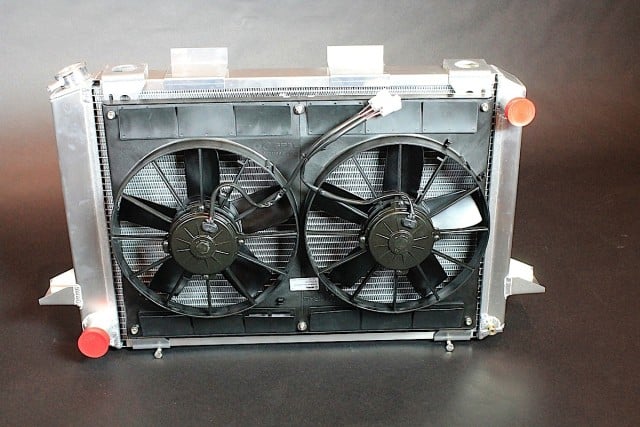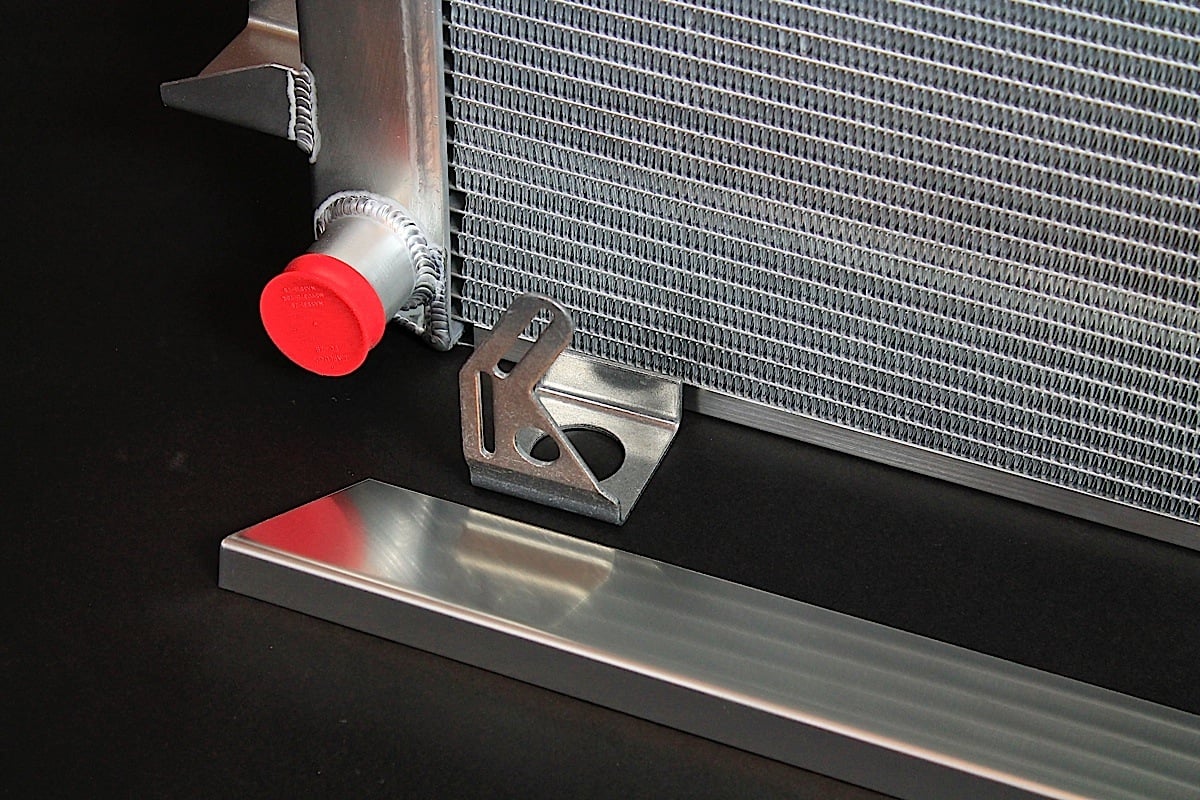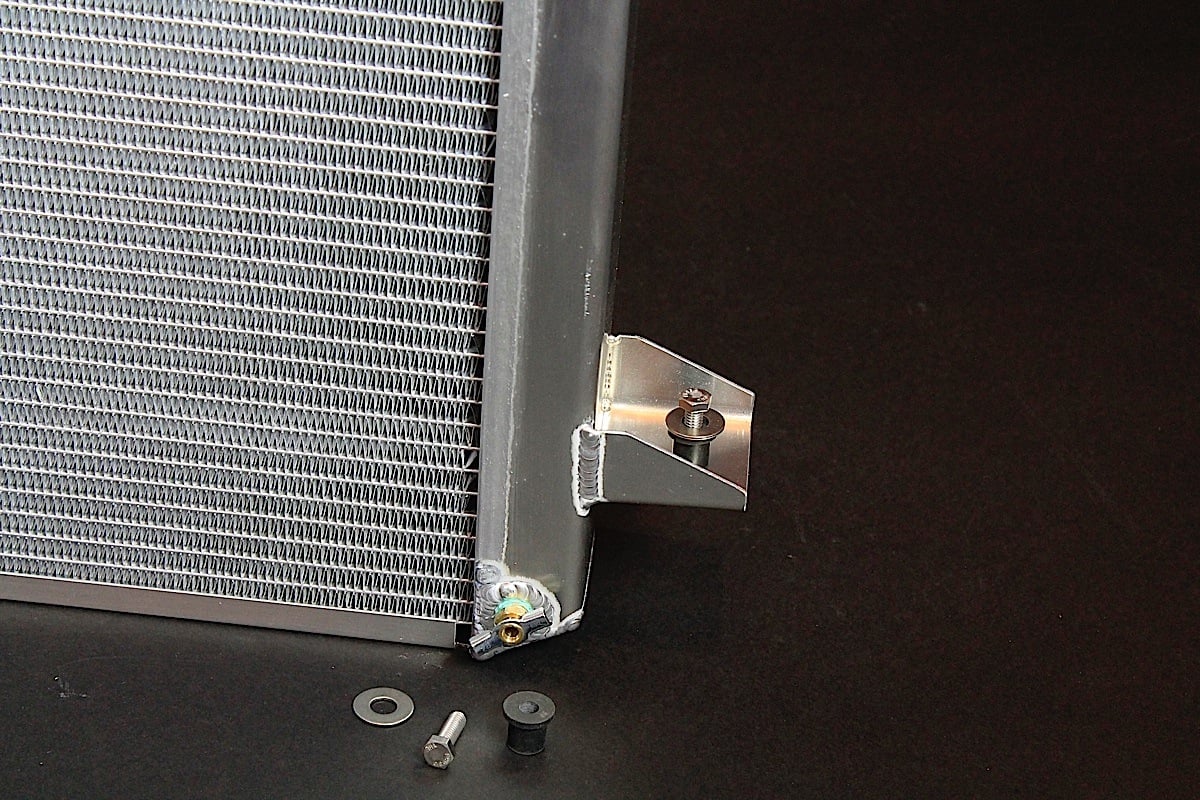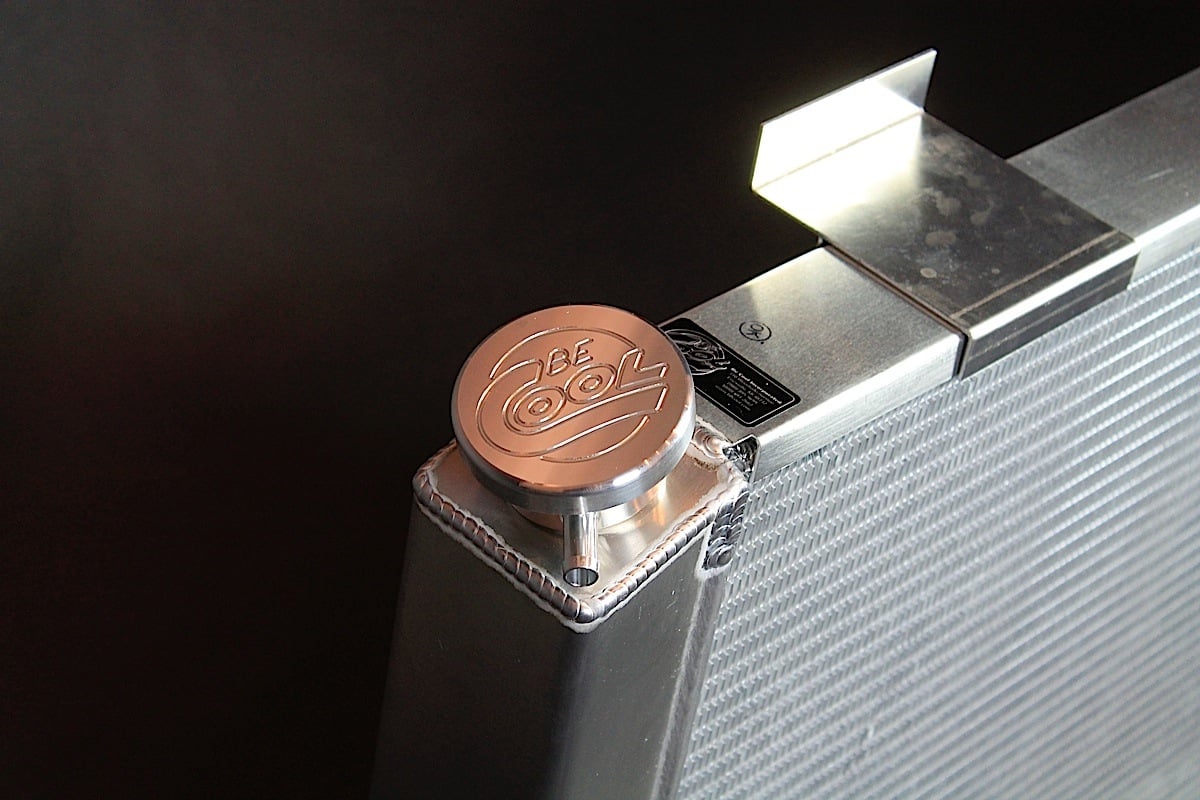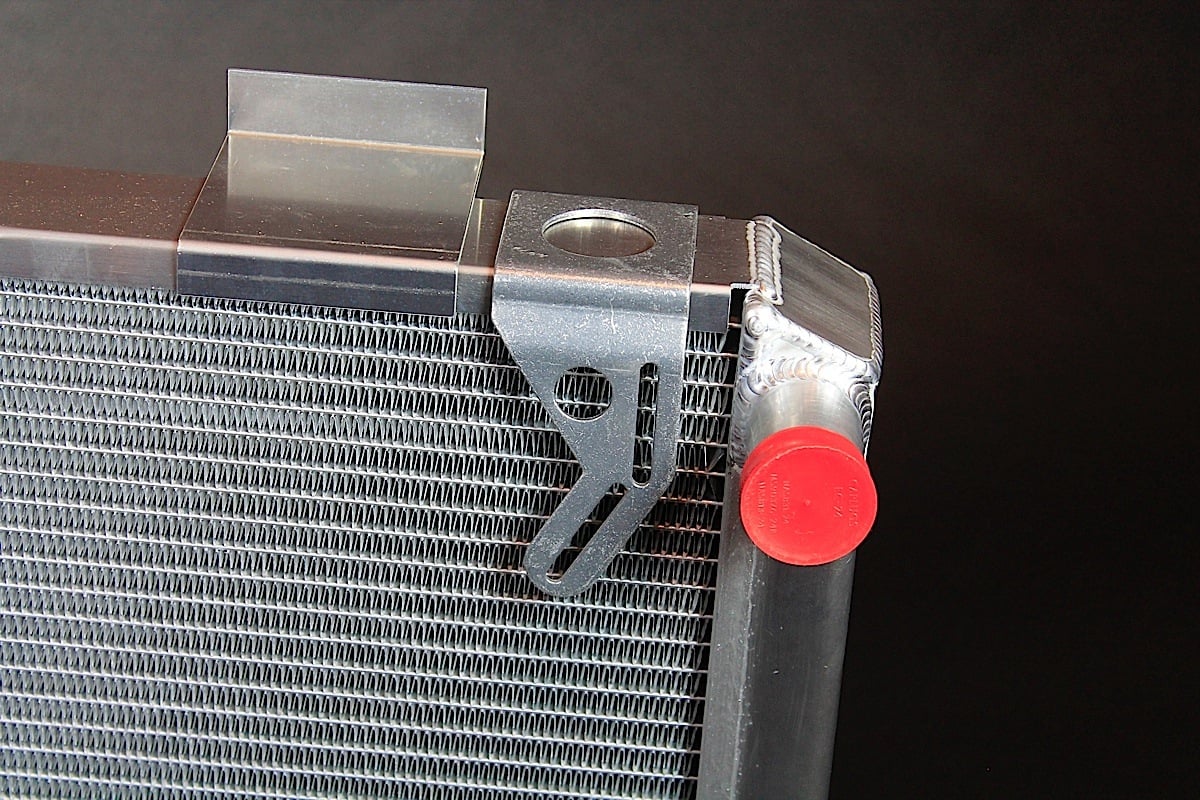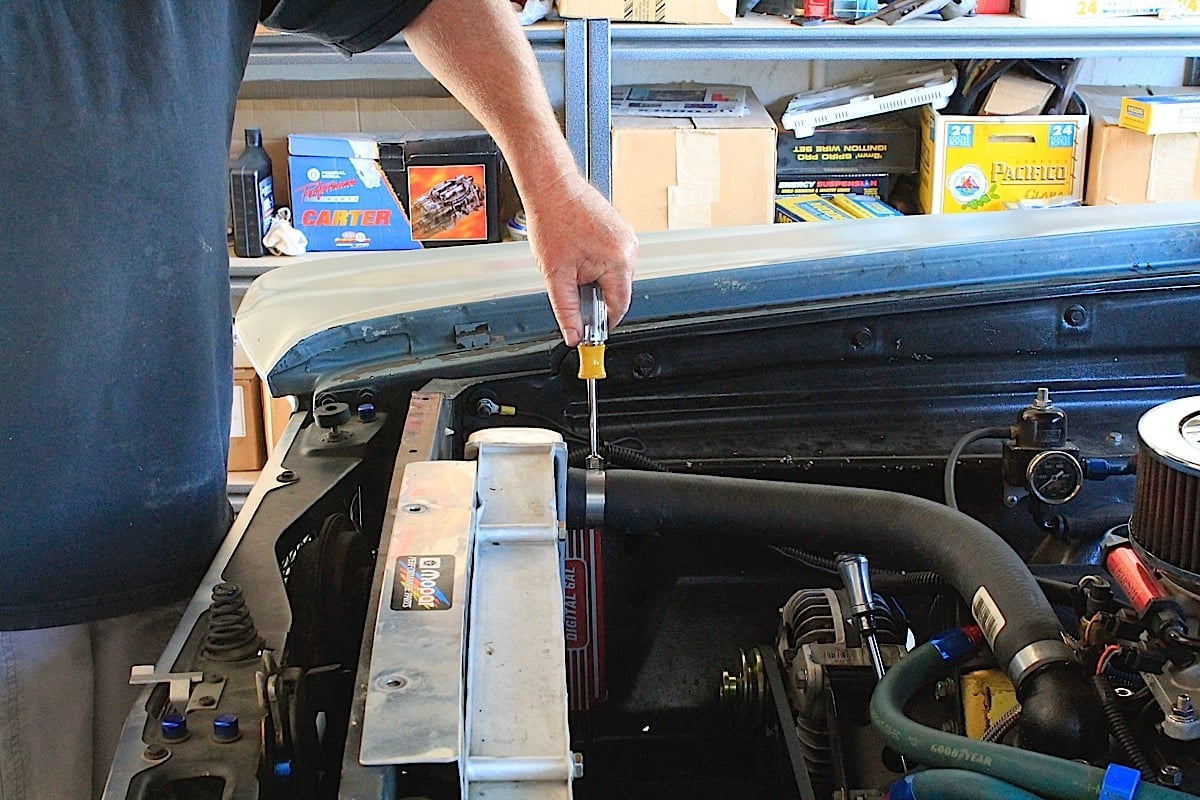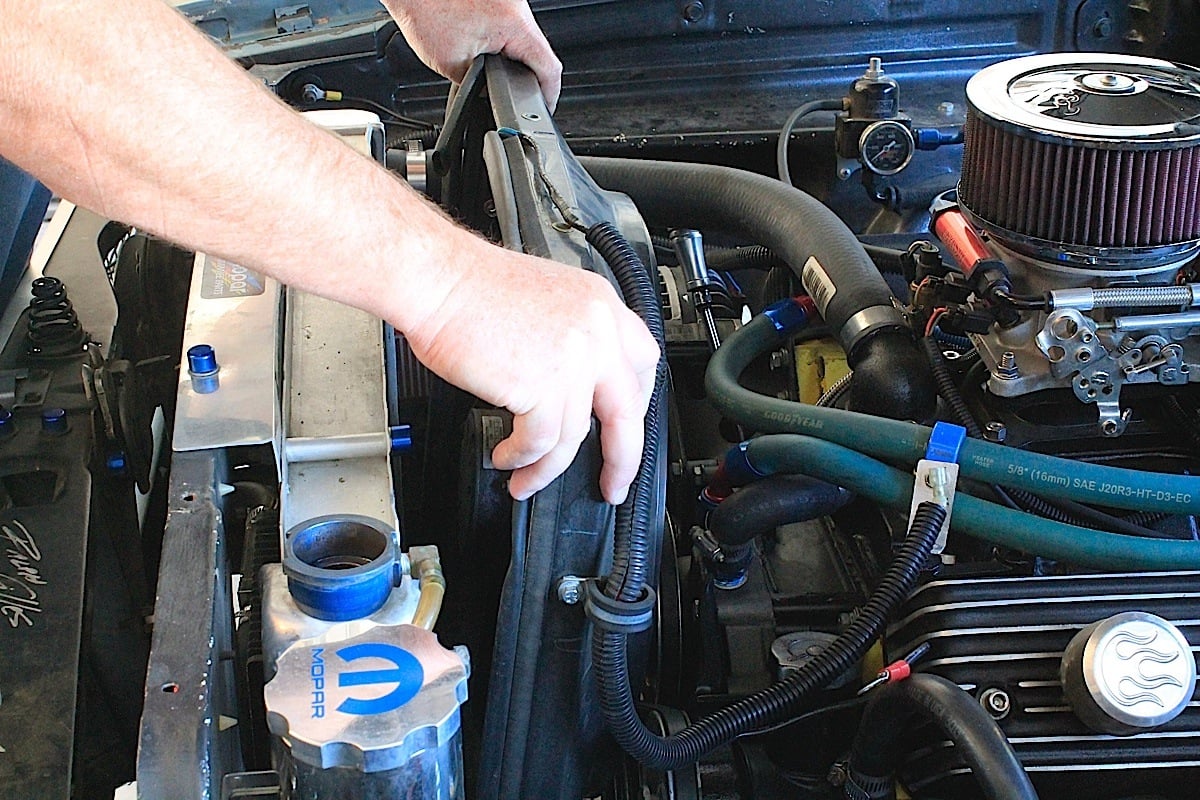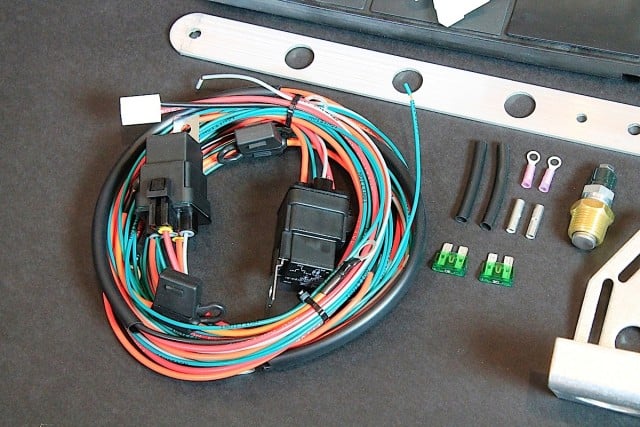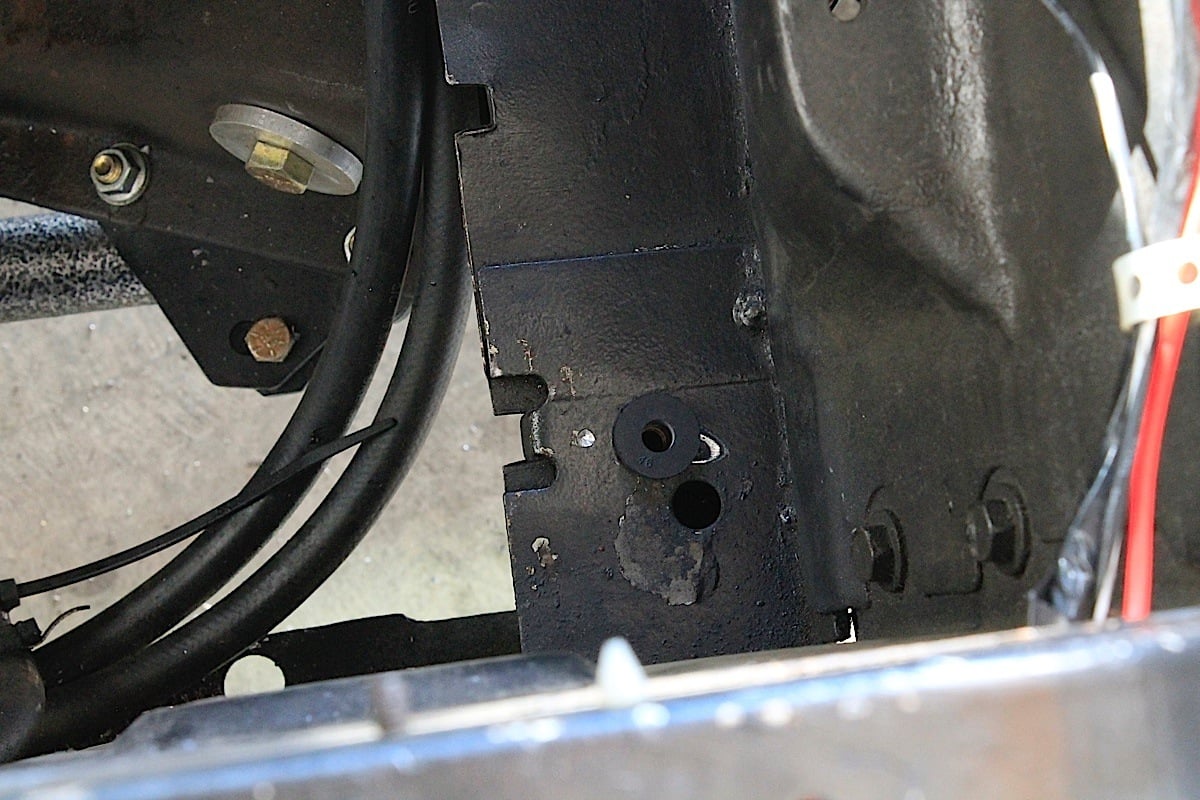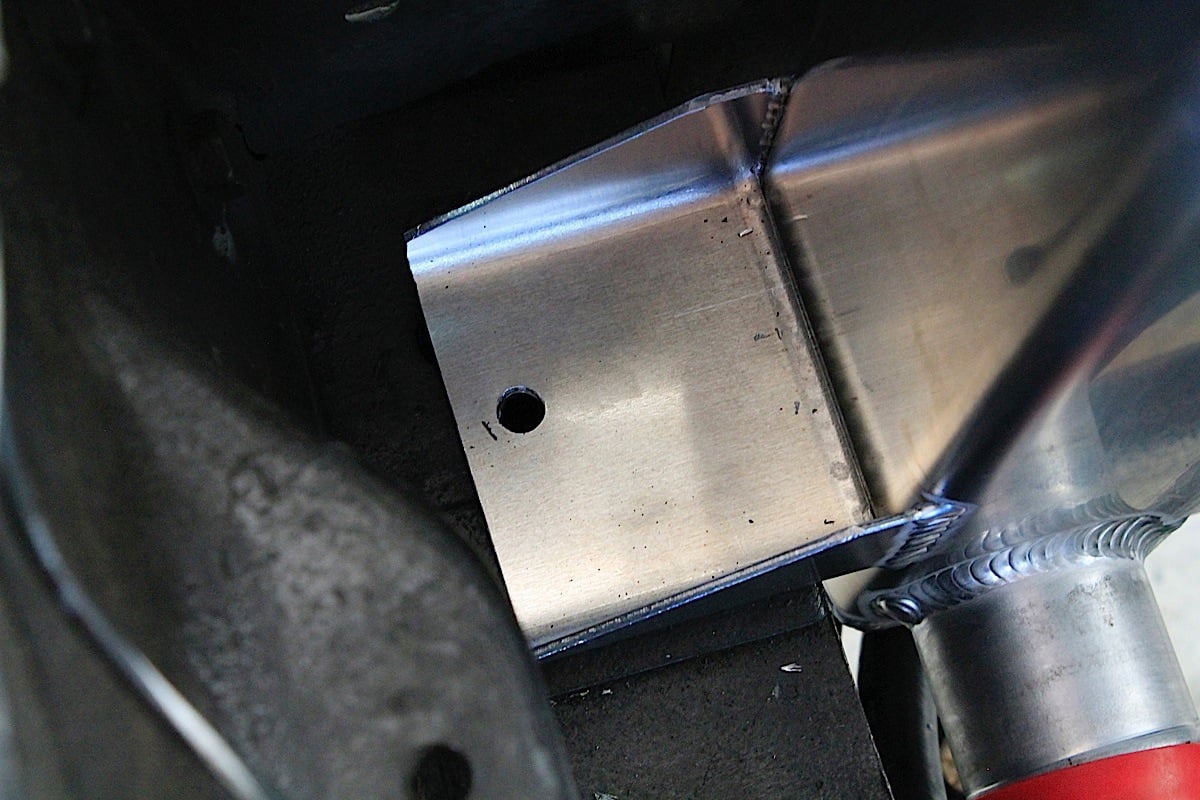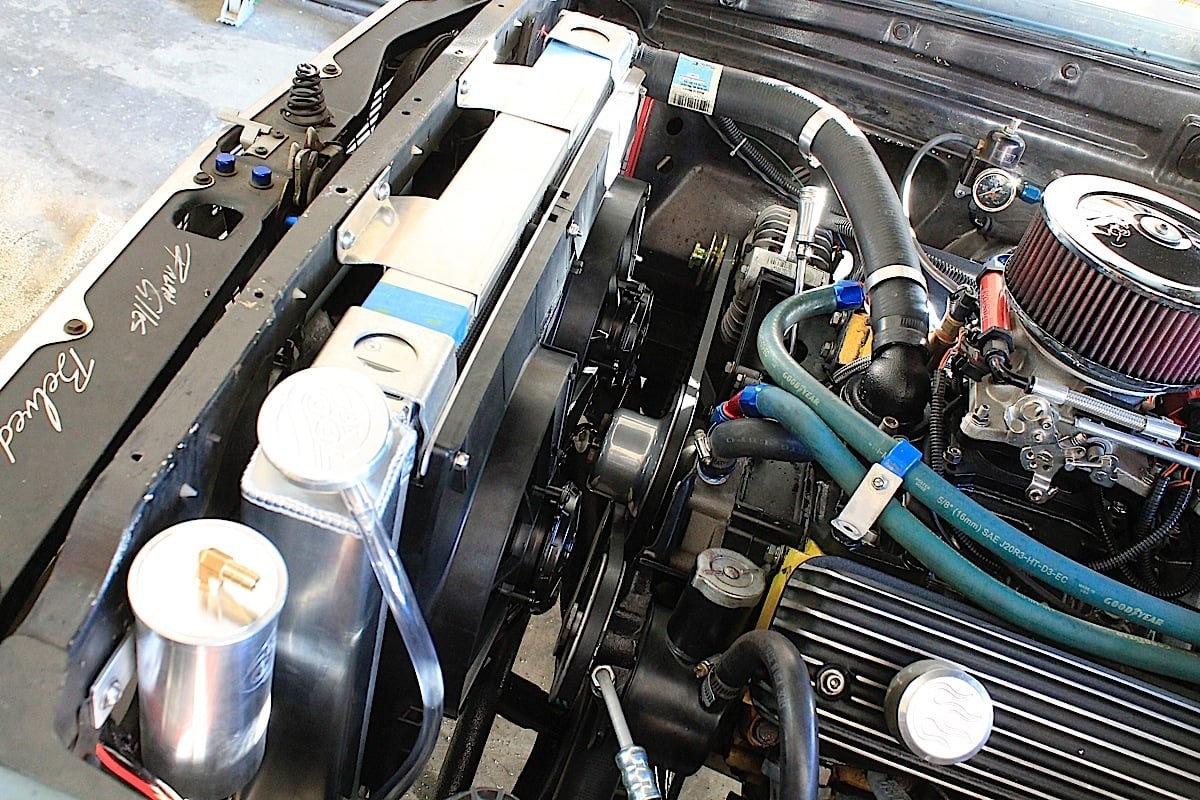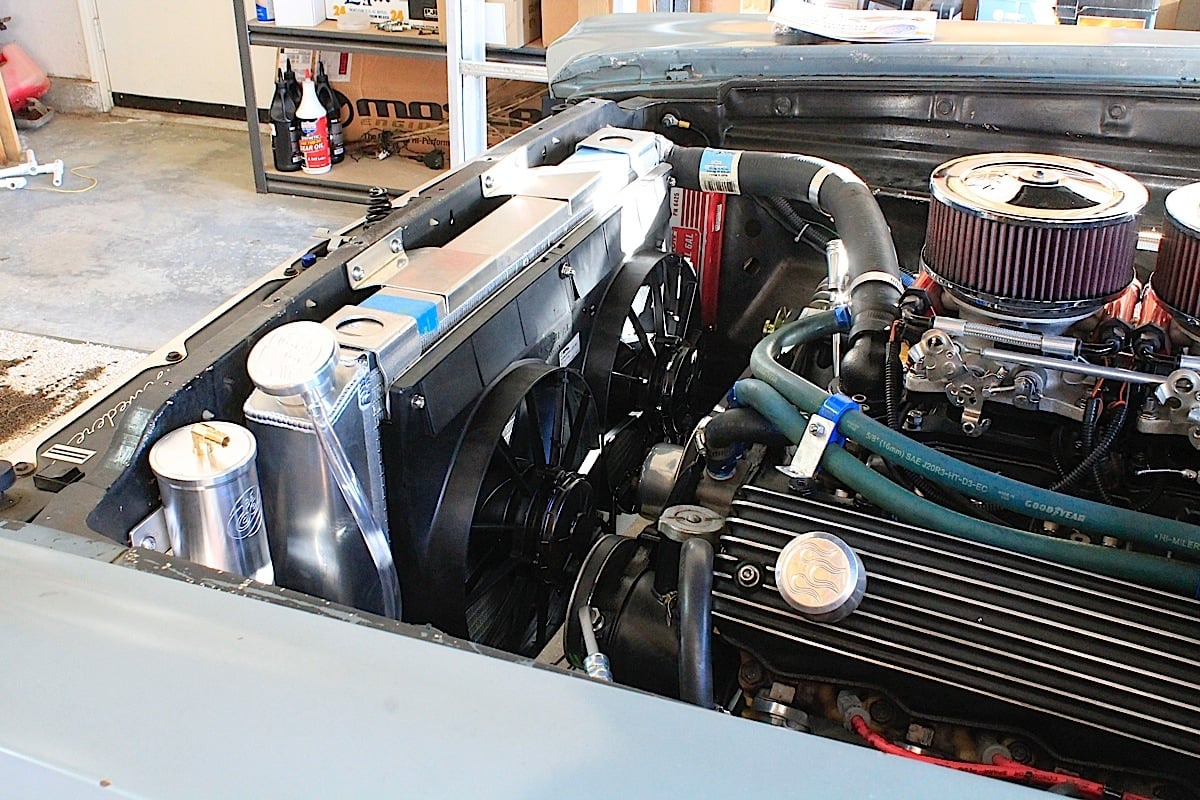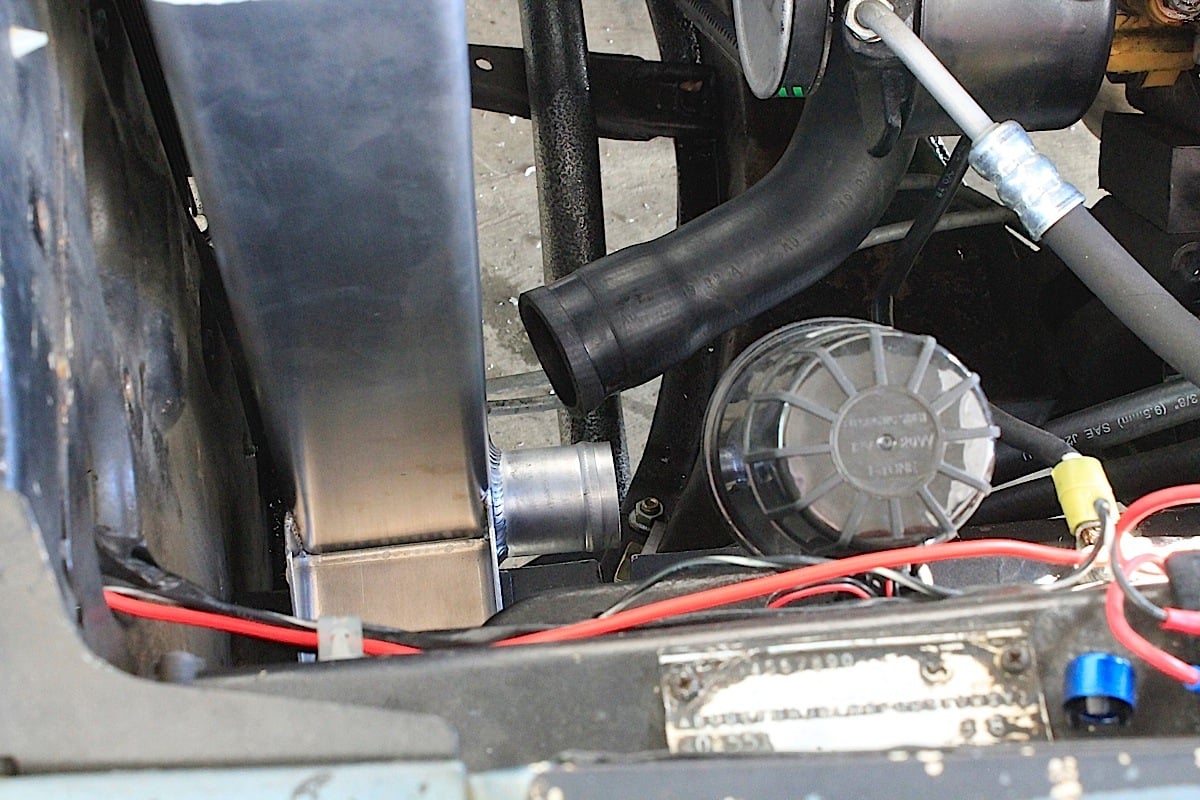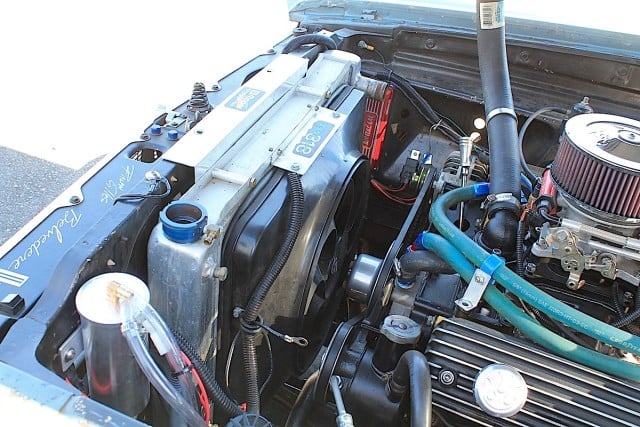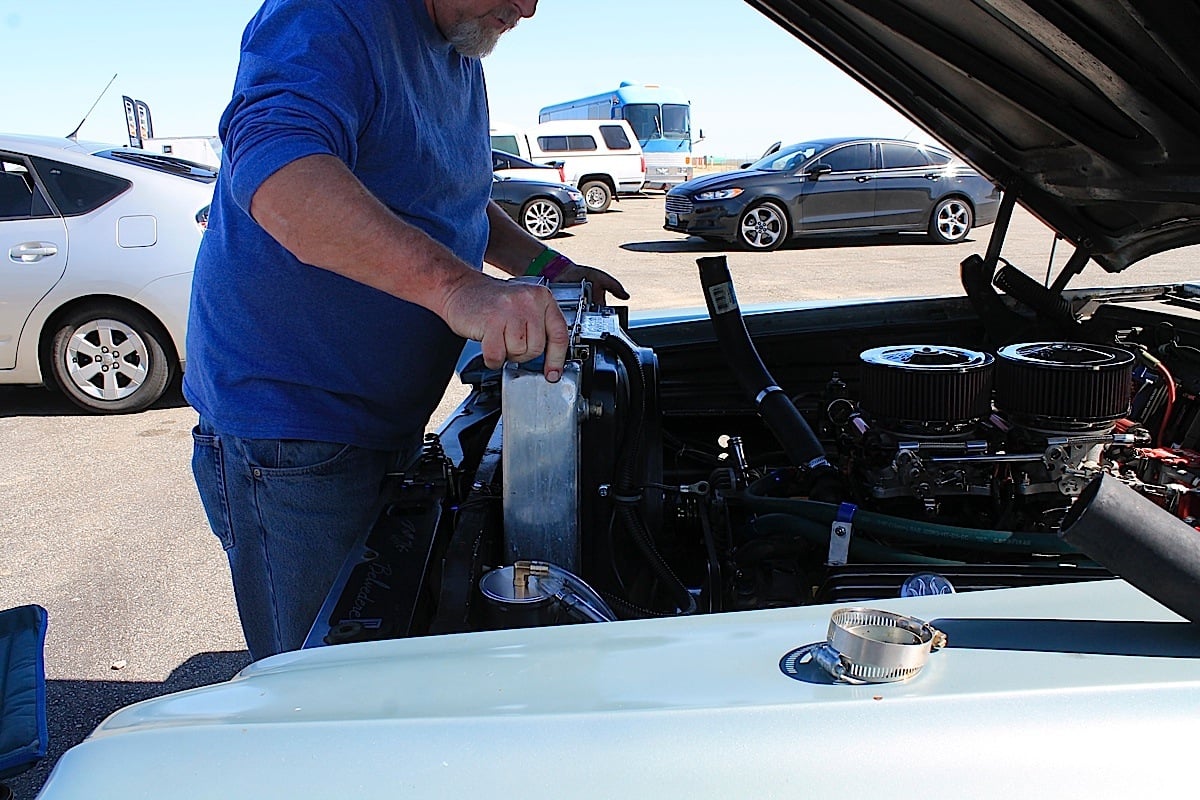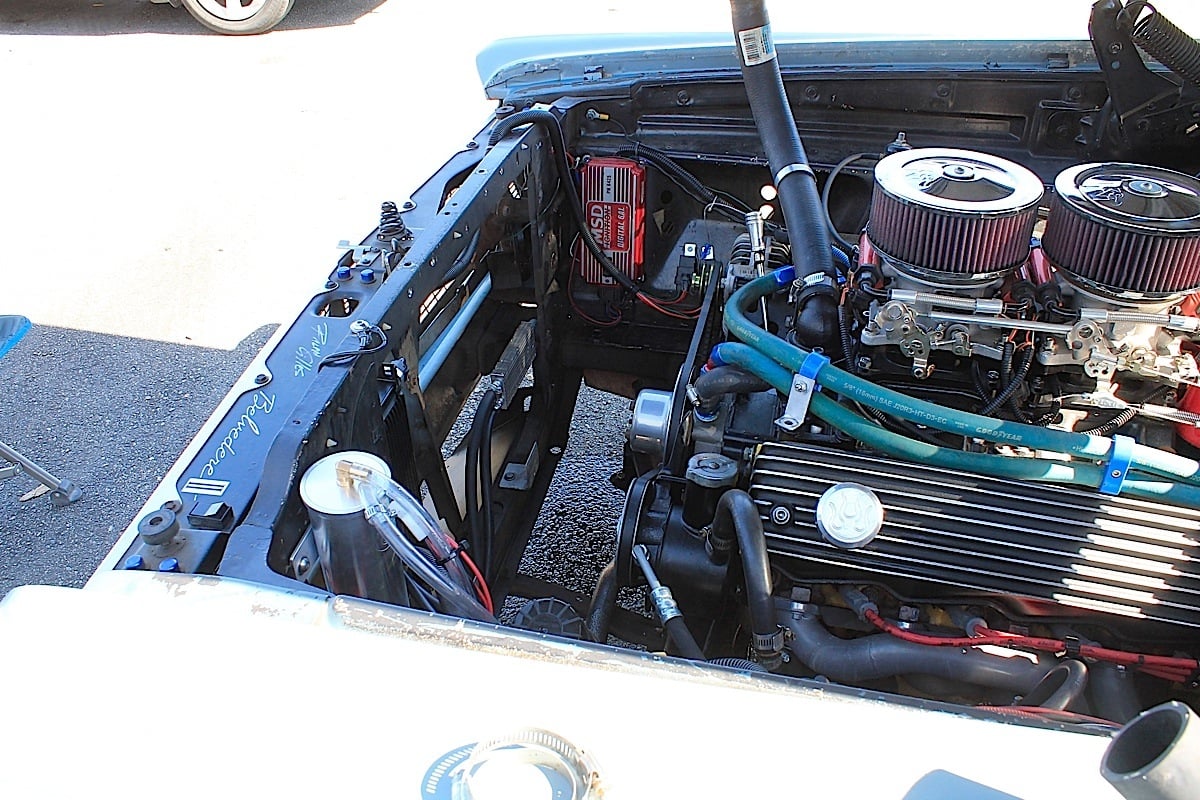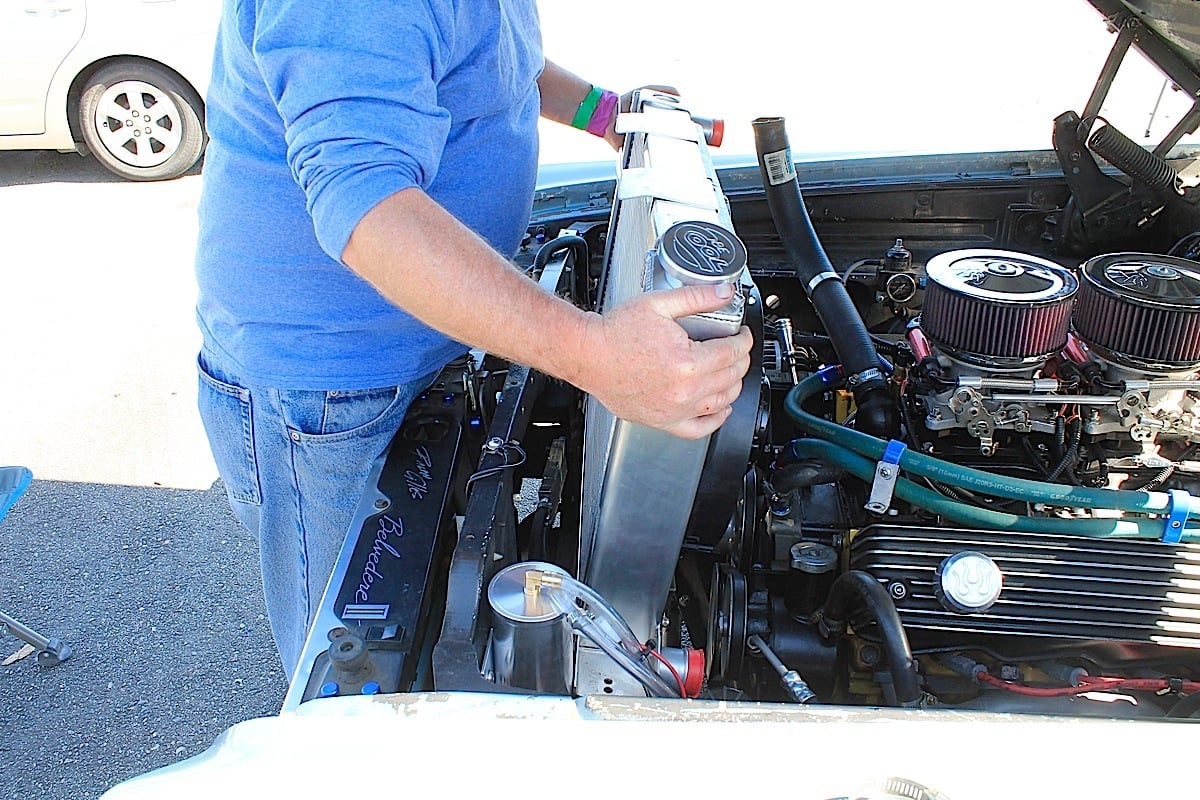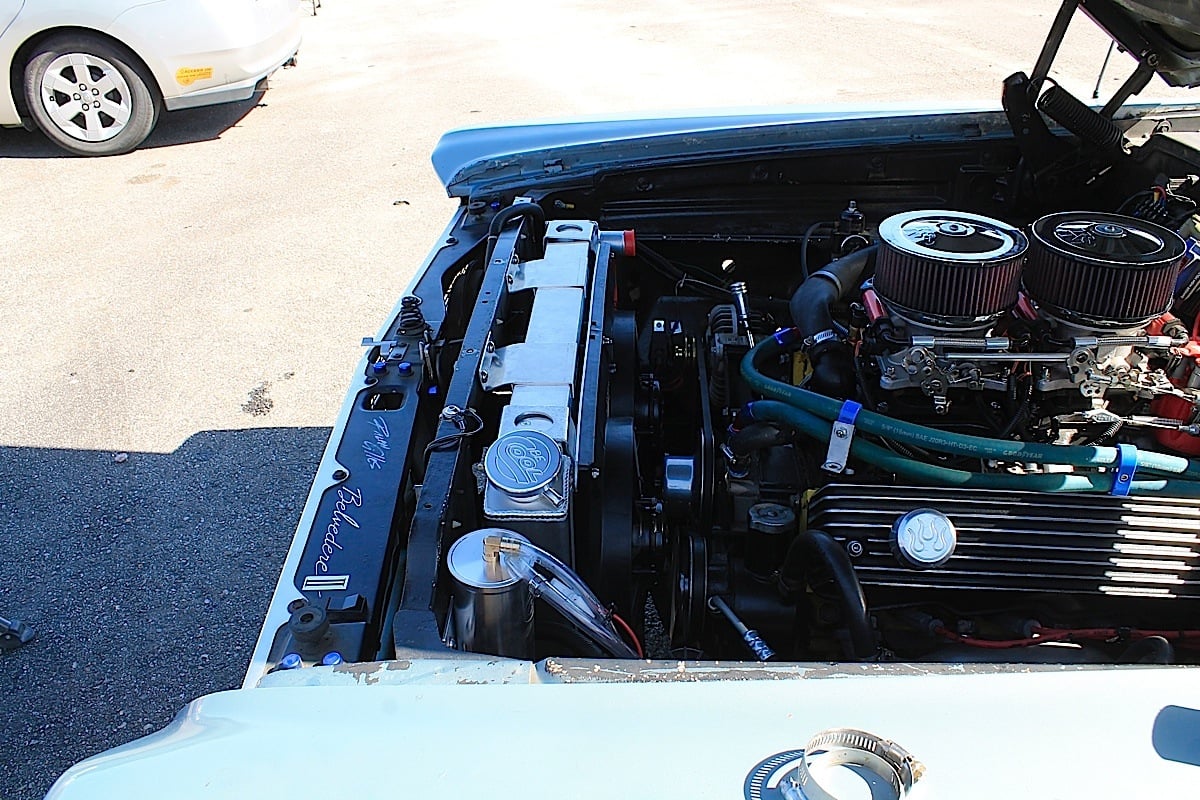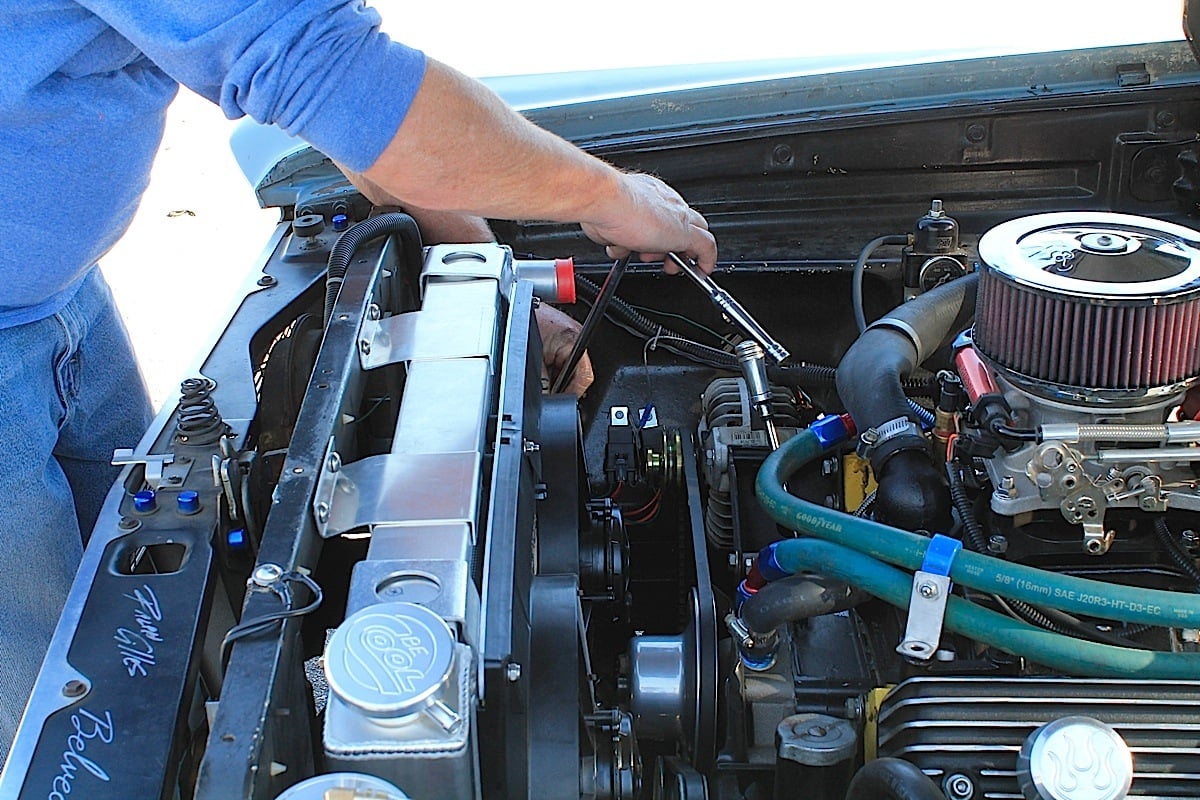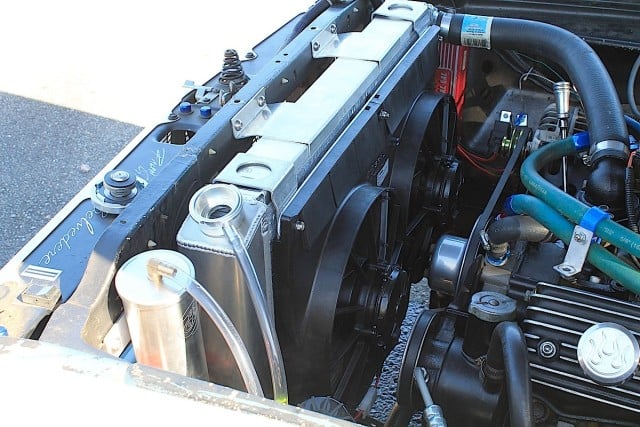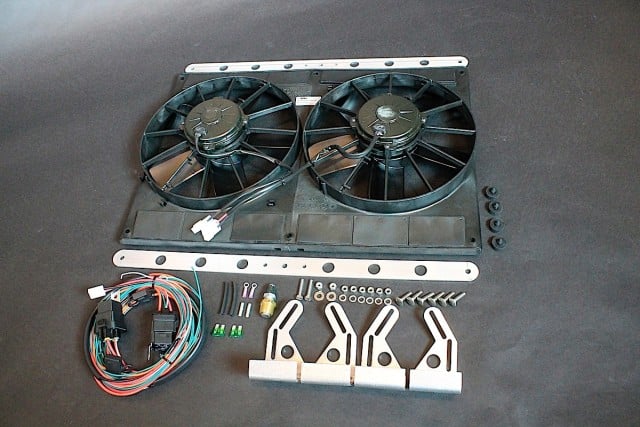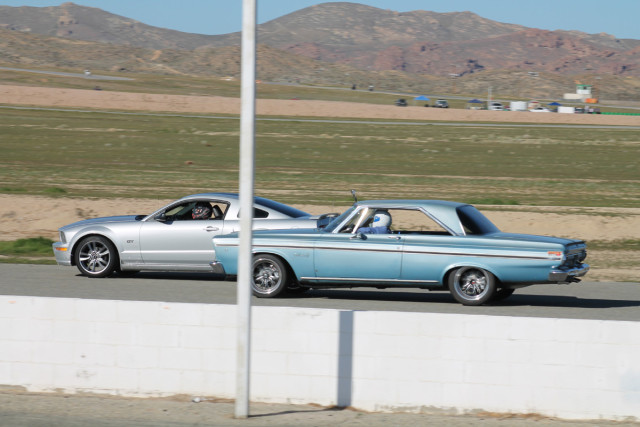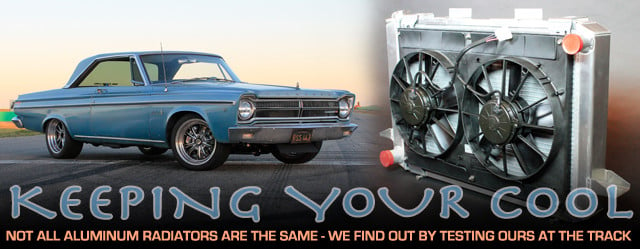 The cooling system is often overlooked when it comes to hopping up a musclecar. When we add horsepower, we typically consider that it will have an effect on the rest of the drivetrain. But why does the cooling system get ignored? We all know that more power often generates more heat, and that additional heat requires more cooling.
The cooling system is often overlooked when it comes to hopping up a musclecar. When we add horsepower, we typically consider that it will have an effect on the rest of the drivetrain. But why does the cooling system get ignored? We all know that more power often generates more heat, and that additional heat requires more cooling.

Cruising to a local car show didn’t put too much stress on the engine, but sitting in this kind of traffic was a different story.
When your car came off the assembly line it was built with a system of checks and balances: the electrical wiring was suitable for existing current load, the brakes were adequate for the weight of the car, and the cooling system was sufficient for keeping the engine running at operating temperature. But if you’re adding power and not upgrading the cooling system, those operating temperatures can start to rise. We particularly noticed that our cooling system was inadequate after we started racing Project Track Attack. As we pushed the car harder, the temperatures began to rise towards unsafe levels.
It’s quite common to see an aluminum radiator upgrade on a musclecar, but just installing any aluminum radiator isn’t going to guarantee cooler temperatures – there’s a bit more to it than you think. When the factory installed big-blocks with more horsepower, the standard radiators were upgraded to three- and four-row versions. Likewise, there are also aluminum radiators designed for higher horsepower levels – one size doesn’t necessarily fit all. We reached out to Be Cool and got some answers to the questions that people have been asking about aluminum radiators for years, namely, how do you choose the proper aluminum radiator for your car?
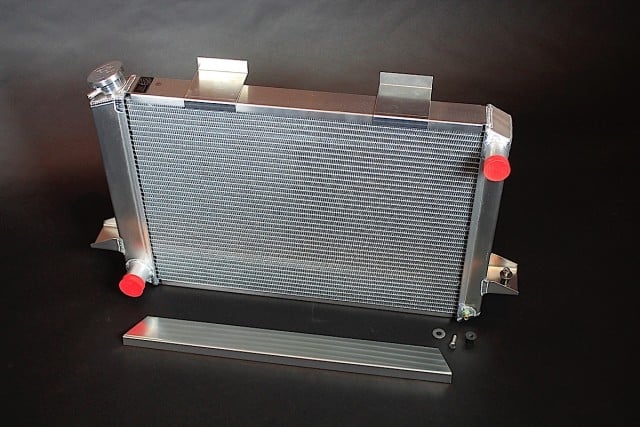
The name on the cap says “Be Cool”, but can this aluminum radiator live up to its name? We put it to the ultimate test by taking this radiator out on the racetrack.
Are Aluminum Radiators Better?
If you ask just about any purist, they’ll tell you that their factory original copper-core radiator has always kept their engine running at 180 degrees – with a mechanical fan, no less. With regular maintenance and upkeep on a factory style radiator, it’s very true that one can sustain a copper-core radiator and not have any issues, such as overheating. That’s fine for a car that remains completely stock, and a regular cleaning and occasional rod out will help keep your cooling system performing at its optimum efficiency.
Larocque said, “Copper is a very efficient material for cooling, however, it is bonded with lead, and lead is a major heat soak. Be Cool radiators are made with a quality grade aluminum and are 100 percent aluminum welded. We don’t use epoxy on our radiators.”
Furnace brazing is when a dissimilar material is used to join metal components. These materials can include copper, aluminum-silicon, silver, nickel, or a variety of materials. Brazing occurs when the filler material is placed between the two metals to be joined and the assembly is put in a furnace and brought to brazing temperature.
Epoxy will expand and contract at a different rate than the aluminum that it is bonding, and therefor it can lead to separation and leaks. Epoxy can also act as an insulator and it does not transfer heat as well as aluminum, and it reduces the radiators ability to dissipate heat.
Dissipating heat depends on several factors: the grade of aluminum, the number of fins per inch, the thickness of the tubes, and the core size. The size of the tanks don’t really have any affect on cooling; the core size is what helps provide the cooling properties.
Larocque added, “Aluminum radiators can weigh as much as 50 percent less than a comparable copper-core radiator, and provide up to 20 percent better cooling capabilities.” But there are more decisions to make when choosing an aluminum radiator.
Copper is a very efficient material for cooling, however, it is bonded with lead, and lead is a major heat soak. -Justin Larocque
Laroque said that both the crossflow and downflow designs will both perform equally well, it’s just a matter of preference – which look is preferred by the vehicle owner. The crossflow has both tanks mounted to the side, and the downflow has an upper and lower tank. How each one mounts to your vehicle depends on the vehicle. There is also a polished finish available for owners who like the highly polished look on their show car; it will require a little more maintenance to keep the shine.
Mounting the radiator was simple, and exactly how it was described: Direct-Fit.
Core sizes come into play depending on the power rating of the engine: a 22-inch core with a single 16-inch fan is for engines rated at 300-400 hp; a 24-inch core with dual 11-inch fans is for engines rated up to 700 hp; and for 1,000 hp a 27-inch core with dual 12-13-inch fans is recommended. Other factors that come into play are thermostats and water pumps. For carburetors or EFI throttle body conversions like we did with our FAST EZ-EFI, a 160-degree thermostat is recommended.
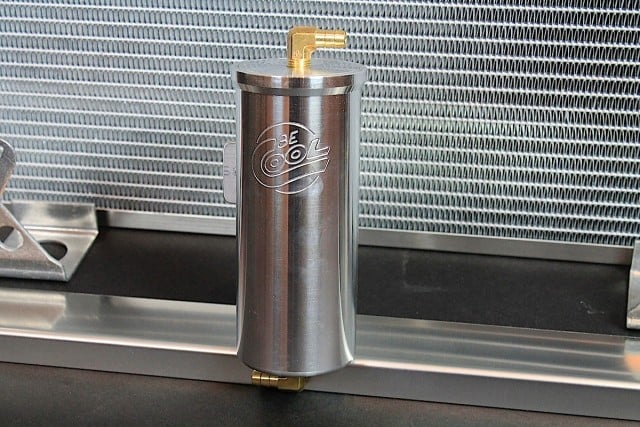
Myth: The reservoir/overflow needs to be mounted with the top of it level to the radiator cap. It can be lower, as it works on vacuum/pressure, not fluid level.
For EFI vehicles, or conversions where programmable tuning is an option, Larocque recommends a 180-degree thermostat. High-flow water pumps can also be an issue because they move the coolant too quickly, therefore not allowing the radiator to perform it’s only function: to keep the engine cool. High-flow can be okay for dual and triple-pass radiators, but a standard volume pump should be sufficient.
With some vehicle models, the radiator outlets are dependent upon what engine is in the car, and even the year of the engine. Early Mopar small-blocks had a driver side lower hose, while later years it was on the passenger side. Answering a few simple questions about our vehicle led us to PN: 80170 for a B-body Mopar, which can be found on JEGS.com. The module is a direct-fit unit that comes complete with dual electric cooling fans, mounting brackets, fan support brackets, and a dual relay kit.
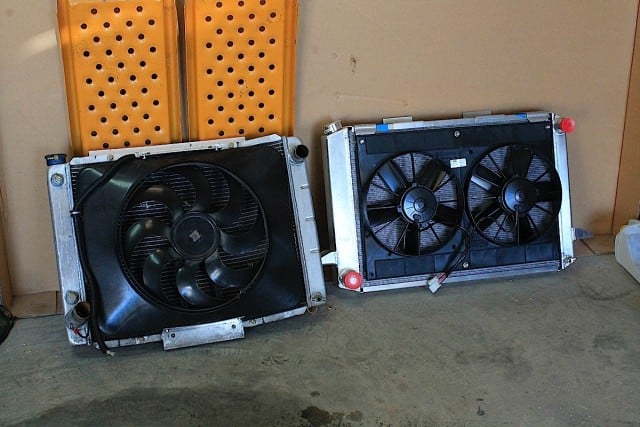
The core sizes were very similar and the single 16-inch fan dwarfed the 11-inch fans, but the results were what we were after – not size.
Prepping For A Track-Side Installation
The original radiator was designed for racing, meaning it doesn’t come with a petcock or any mounting brackets or tabs. It’s a production-line, two-row aluminum core that is fully welded with no epoxy. The crossflow radiator filled the core support at 26-inches wide and 19-inches tall. Keeping things cool was a name brand, single electric cooling fan with a built in shroud. The shroud was the same size as the core, and it moves a bit of air with over 3,300 cfm. On paper, this radiator and fan combination should be sufficient but we’re not just cruising to a local malt shop with this car. We put it up against some modern musclecars and push it hard on the racetrack.
The Be Cool radiator is also a crossflow design, and it is similar in dimension at 29-inches wide and 18.5-inches tall, with a 2-inch core thickness. Pulling the air through the radiator is a pair of 11-inch Spal electric fans rated at 2,720 cfm. We loved the fit of the radiator – it took far less creativity in mounting the fan because it’s a direct-fit unit. The addition of the two ‘feet’ that mount the radiator to the frame rail is part of what made it simple, and secured the radiator to the more-solid frame rail.
Top: With the included mounting brackets for the fan module, it was much simpler to install than the prior set up, which required some creativity.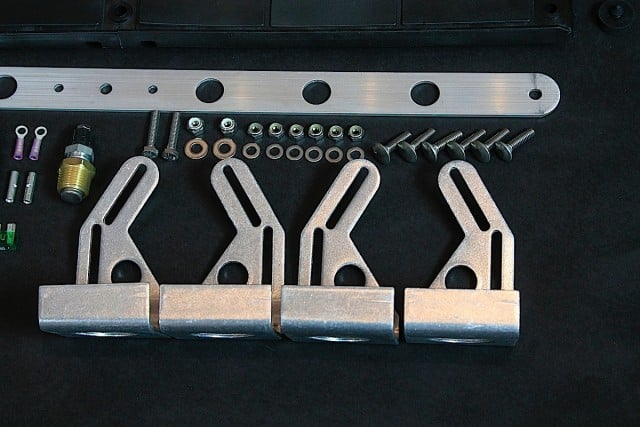
Bottom: We wanted track-side swapping to be done quickly, so we kept the process very simple.
We take our car road racing a few times each year, and depending on the time of year we can see some pretty high temperatures. Last fall we weren’t happy when our Dakota Digital gauges started beeping at us as the temperatures approached 240 degrees. Our original eBay radiator kept the temperature fairly consistent during cruising, and on longer trips it wasn’t too bad. But during the hotter months, and while racing at the track, our bargain radiator started to tell us a different story.
During the summer months, 210 degrees is not a dangerous situation, but we know that with the proper cooling system we should see lower, steady temperatures – even during the hottest months of the year. If you watch your gauges like we do, you probably get a little uncomfortable when you see the needle rising past 210 degrees. So we decided to purchase a Be Cool radiator and take it with us to the race track and do a comparison between Be Cool and our original aluminum radiator.
At home, we performed an initial dry run with the new Be Cool crossflow radiator module. We did the full installation prior to heading out to the track to make sure that any wiring or hose upgrades could easily be completed between race sessions at the track. We also swapped in the recommended 160-degree thermostat during this dry run so that all conditions were identical and the swap was only the radiator – no other components would skew our results.
We decided to upgrade the existing wiring to accommodate both the single and dual electric fans, and we needed to get a new lower hose. Other than that, the installation was very straight forward, and with a few holes being drilled the radiator went in with less effort than our bargain eBay radiator. Installing our radiator meant drilling a total of six new holes, swapping a hose, and the new wiring harness.
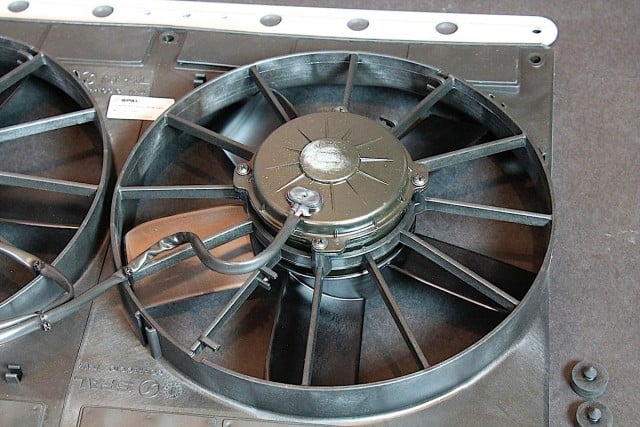
Dual 11-inch SPAL cooling fans are included. Larocque tells us that reversible fans (pusher/puller) are not as efficient as dedicated fans, the blades are designed to be more efficient with a dedicated pusher or puller fan.
We had been a little creative with our bargain radiator, using aluminum stock from a local home improvement store, but the mounting for the Be Cool radiator was much simpler. Welded to the side tanks of our crossflow radiator is a pair of brackets that sit on top of the frame rails. The upper clamps hold it securely in place when bolted to the upper crossmember.
We set the radiator in place and drilled two holes to match the mounting bolt size, and then redrilled the hole on the frame rail to match the size of the rubber mount. The rubber mounts have a threaded insert and when placed in the frame rail the bolt pulls the rubber mounts and expands them to hold the radiator in place. On the upper crossmember, a little tweaking of the upper clamps allowed us to line up the clamps with the upper crossmember, and the four holes were drilled.
A temperature sensor is included with the kit to turn the fans on at 185 degrees, and back off at 165 degrees, and that is mounted directly into the intake manifold or water pump housing. For us, we have the EFI conversion which includes a programmable fan trigger, so we wired that trigger into our relays to control the fans.
Top: A single hole in each frame rail was all that was needed to mount the radiator.
Bottom: the upper clamps were bent slightly to align better with the upper core support. We needed a longer hose, and a trip with the old one to a local parts store did the trick.
The Test Results From Willow Springs International Raceway
On Saturday morning, we made our initial run out on the track with our eBay-bought radiator installed. After a few times around the track, we checked our temps and recorded them, it was a bit cooler in the morning but we still began to see over 220 degrees. It didn’t seem to get much higher, but it was still a bit more than we would like. We didn’t want to see the higher temps like we noticed last fall, so we limited our testing to the morning run when it was cooler.
The swap was simple, we drained the coolant, loosened both hoses, unplugged the harness, and with just four bolts the old assembly was out.
We brought the car back into the pits and and began the swap from the eBay radiator to the Be Cool radiator. We noted that the sizing difference between the two radiators wasn’t much, and for most enthusiasts the assumption is that bigger is better. While that may be true for some things, we weren’t exactly sure what to expect from the new radiator being that it had roughly the same size core.
The new module was kept pre-assembled, and dropped into place easily. Six bolts, two hose connections, and plugging in the harness was about as simple as it gets.
Going into this comparison the way we did is risky; what happens if you go into something like this and the results are not what you’re expecting? For Larocque there wasn’t any doubt about it, and he loved the idea of putting up his Be Cool radiator against another name-brand radiator and doing a comparison like this. We also asked him about coolants, mixing with water, and additives like water wetters.
Larocque recommends using deionized water over distilled water, due to a better pH balance, but distilled water is far better than tap water. Tap water contains chemicals such as iron and calcium, which is very bad for the aluminum core. Poor water quality can be high in either element; calcium can corrode the aluminum and iron can cause electrolysis.
Be Cool coolant is a 50/50 mixture of deionized water and coolant, and is sold by the one or five gallon container. “Using a water wetter can lower the surface tension of the water and make it more slippery, and it works as a good lubricant for water pumps,” Larocque said, “there’s no harm in it.”
After swapping the radiators and heading back out on the track, we had more reason to wonder if our comparison was going to pass or fail: we took the first test at 8:30 am when the outside temperature was very cool, and humidity was low – plus our car had been sitting overnight and the block was cold.
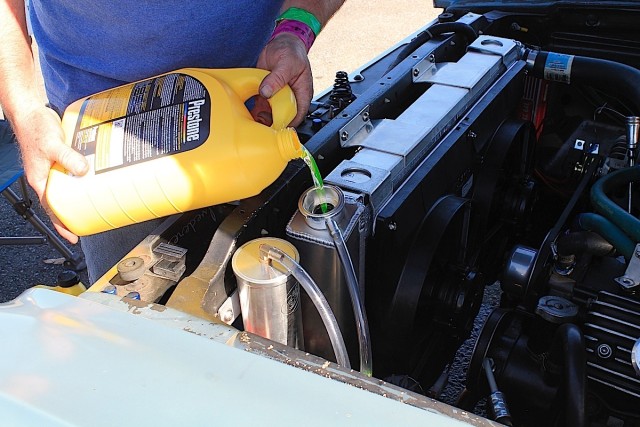
A standard glycol-based coolant is sufficient, with a 50/50 ratio of distilled or deionized water only.
After we installed the Be Cool radiator, it was much warmer in the afternoon – meaning the on-track temperature could possibly be even more than we expected – and the engine block was already hot. Would it be a fair comparison?
After seeing 220 degrees in the morning, we were rather surprised with the temperatures that we saw in the afternoon with the new Be Cool radiator. Our warmest temperature that we detected on the track that afternoon was about 180-185 degrees. That meant that we saw a drop in on-track temperature of at least 30 degrees, and that meant that our test was successful.
The Be Cool radiator and twin Spal fans helped Project Track Attack keep its cool even under some of the more punishing conditions: racing with the pedal to the floor.
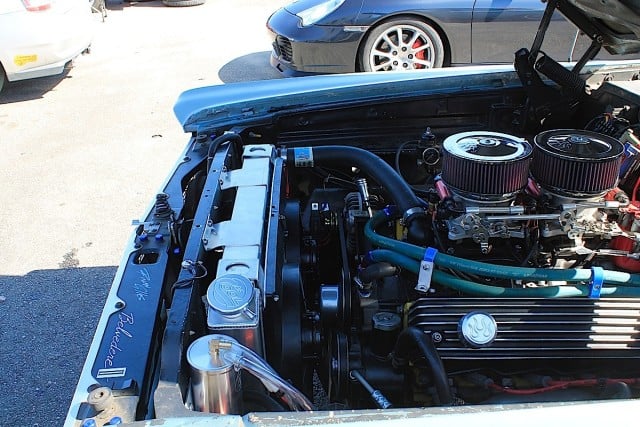
We were ready to hit the track again after lunch with our new Be Cool radiator installed. But the real test came the next morning with near identical conditions.
Why Choose Be Cool over eBay?
When we spoke to Laroque, one issue is undeniable: price point. He is aware that Be Cool modules are expensive, but when you compare the price of a Be Cool radiator to a radiator purchased on eBay, it’s not exactly a fair comparison.
Most inexpensive radiators on eBay are simply a pair of tanks and a core, and they might even be fully welded aluminum. But they’re generic in dimensions, and not designed to be a direct fit, like Be Cool. The buyer must figure out their own brackets/fitment, and even then it is still not going to be a perfect fit – it could be smaller, or even a little bit larger than what is needed.
When you add up the extras that are provided by Be Cool, you’ll actually see that the two become quite a bit closer in price than you might imagine. Sure, you can buy the bare minimum and the least expensive components to complete a build-it-yourself cooling module, but when you compare quality for quality, the eBay radiator isn’t really that much of a bargain.
You can buy less expensive components, but you won’t be getting the same quality that you’re getting with the Be Cool radiator. Using quality components is what sets Be Cool apart from the bargain-priced radiators and components.
But Wait, There’s More!
When we head out to Willow Springs, we go for the weekend. That’s not one day of racing, but two full days of pushing our car harder than it gets pushed the rest of the year. We already knew that our Be Cool radiator was keeping the temperature down to well below 200 degrees, which was a big drop from our temperatures last October when we saw over 230 degrees.
But what about that “unfair” comparison where we ran the old radiator in the morning on a cold engine, and then ran the Be Cool radiator in the afternoon on a hot engine? We wanted to see what kind of track temperatures we would see first thing in the morning while the car is warming up on the track. With the outside temperature still in the 70s, we hit the track and took note of our temperature and for the first session of the day we were running at about 170-180 degrees – meaning that our first-run, cold-weather temperatures were about 50 degrees cooler than the day before with our other aluminum radiator.
We are skeptical at times, and we want to provide our readers with real tests that aren’t based on a stacked deck, and this test was one that had us sitting on the edge of our seat. Since we had announced to a few other enthusiasts at the track that we were doing radiator testing with before and after results, we had a few others interested in finding out the results, too.
Although we did an initial dry-run installation the day before the racing, we never tested it out because we wanted to see the results when everyone else did. Tests like this are what it’s all about: getting real results in real world testing and not relying on someone else to tell us that their “independent tests” gave positive results.
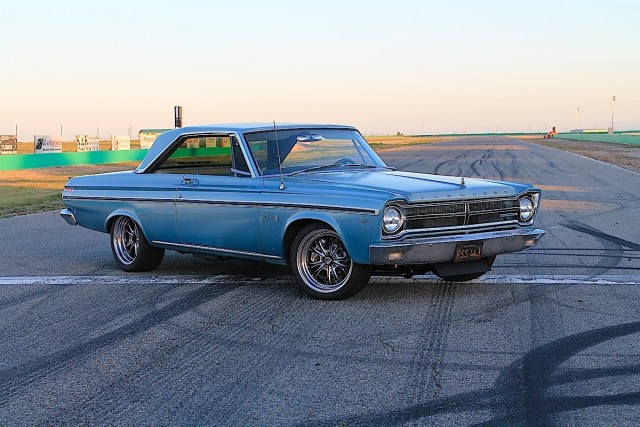
An opportunity to pose at the start/finish line couldn’t be passed up. At least now we have one less thing to worry about when we race.
So what would happen if we didn’t see a reduction in operating temperatures? Larocque didn’t have a single doubt; as a matter of fact, when we called him we told him, “We didn’t see the 20 degree reduction that we expected.” He laughed and responded, “What was it, like 40 degrees?” The man knows his product well, and we couldn’t fool him.
The price point of a quality radiator and fan system like this is a bit higher than most people expect, but it’s well worth the investment – especially with the results that we obtained. A typical aluminum radiator can be a little less, and good quality cooling fans can be in the $300-500 range. We went the inexpensive route before and we saw higher temperatures than we cared to see. But after the test, and the weeks since then, we haven’t seen anything over 185 degrees – which is when the fan kicks on and our temperature drops to about 160-170 degrees. You have to ask yourself if spending a little more to protect that expensive engine you built is worth it, and we say it is.
Be sure to check out the Be Cool website for your radiator application, for racing, street, and performance vehicles from 300 up to 1,000 horsepower applications. They have everything you need; whether it’s a cruiser, occasional track star, or a show car – you’ll definitely “be cool” this summer with an upgrade like this.



